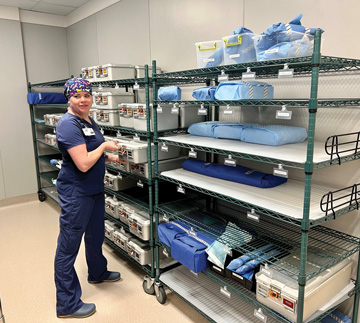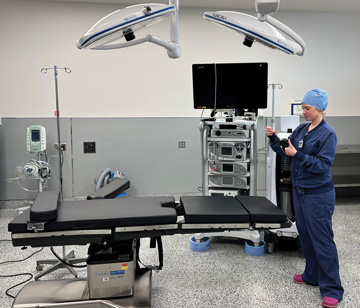Zero is always the goal. Our surgery center works tirelessly on multiple fronts to ensure no patient walks away from an elective procedure with a surgical site infection (SSI). Of course, hitting that elusive benchmark is always a daunting proposition — especially lately. Since January 2020, we have doubled our capacity while adding total joint replacement and spine surgeries to our scope of services, with the added stress of COVID-19 arriving very shortly after we began our expansion of services. Not to mention the fact that we’re now seeing many more cases coming to our surgery center that we’re struggling to keep up with the volume, which is certainly a good “problem” to have. Still, we pride ourselves on implementing evidence-based, proactive protocols and practices to minimize SSIs, and our infection rate, currently at 0.4%, reflects those efforts. Here’s everything we do to keep our patients — and staff — infection-free.
- Home
- Article
Working Toward Our Goal of Zero SSIs
By: Kelly O’Brien, MSN, RN, CPAN
Published: 5/18/2022
A mix of protocols, patient education and policy adjustments have combined to keep our center’s infection rate below 0.4%.
• Patient selection and qualification. To streamline and standardize the selection process, we have developed protocols with built-in eligibility criteria patients must meet to have their surgery at our center. Their BMI must be below 50, and they must be in relatively good health with no high-risk comorbidities. If a patient falls into the category of risk, it triggers a further look into the details of the case. Anesthesiologists and surgeons conduct a thorough review of the patient’s medical history to determine whether they’ll accept the case. We consider all our total joint and spine patients to be higher risk for SSIs by default. After all, these patients often receive implants, so we always take extra precautions to reduce the risk of infection.
• Patient education and engagement. We have a nurse assigned to a role we call our “total joint coordinator.” All patients are routed to her so she can speak with them before surgery. Patients must also attend a comprehensive total joints class she conducts along with our physical therapy staff.
When patients come in for their pre-op appointment and decide to schedule total joint surgery, they are automatically scheduled for a total joint class. They must attend the class with someone they know and trust, whom we call their coach. We want the patient to have their coach’s support when they go home. During the class, which multiple patients attend in a room specifically used for this task, our total joint coordinator covers everything the patient and coach need to know for their surgery. The content addresses how the patient will progress through the surgery center, what they need to do preoperatively in terms of testing, their medications, assistive devices they might need such as walkers, preoperative nutrition and what their postoperative experience will be like. The class also covers wound care, a key to preventing post-op infections.
A lot of the class discussion connects to infection prevention, and we find that the more educated and engaged the patient and their coach are preoperatively, the less likely they’ll be to develop an SSI postoperatively. Based on the effectiveness of the in-person sessions, we’re preparing to roll out an online virtual class that can be accessed through our website. Because we operate in Montana, which is such a large state with such a low population density, we know it’s inconvenient for some patients to get to our facility to attend the class in person, as some need to travel several hours to get here. With the virtual class, patients can get all the information they need from the comfort of their own home.

• Antimicrobial showers and prep. Skin prep and nasal decolonization are two components of any effective SSI-prevention protocol. To that end, our total joints and spine patients are instructed to shower using a 4% chlorhexidine soap both the night before and the morning of their surgery. When they arrive on the day of surgery, they’re screened for MRSA and MSSA, with any positive results treated with a mupirocin antibiotic ointment as part of our nasal decolonization protocol, as well as IV vancomycin preoperatively.
Patients have generally demonstrated compliance with the two preoperative chlorhexidine showers, but for added assurance, all total joint and spine patients are also instructed to give themselves a head-to-toe, rinse-free prep in pre-op with 2% CHG disposable cloths for long-lasting antimicrobial protection. We give them six wipes and show them how to treat their skin through diagrams in the preoperative bay. They wipe down whatever they can on their own, and then we help them to make sure they are covered from head to toe.
• Reducing flash sterilization. After discovering immediate use steam sterilization (IUSS) was being employed too frequently — due to a lack of instruments because of backlogs or because we only had one of a certain item in the facility — our center took measures to correct this unsafe tendency. Ultimately, the problem was solved by shifting to rigid containers that also reduce the use of blue wrap and the associated risk of holes and tears that could go unnoticed and possibly result in contaminated instruments as well as the need to quickly reprocess tools needed for a case.
The goal was to reduce IUSS to less than 10%, but our monthly tracking has shown the rate has stayed below 3% since we moved to the rigid containers. If we ever see sudden increases, we immediately dig into the potential reasons.
For instance, in February there were times when instrumentation wasn’t readily available for cases, so we examined whether we needed to purchase more instruments. By tracking our IUSS rate and making sure we stay below the 3% threshold, we uncovered insights into our overall operational efficiency we wouldn’t have otherwise.
• Adenosine triphosphate (ATP) testing. We employ heightened environmental cleaning surveillance throughout our facility, especially in our ORs, using a device that detects the presence of ATP, which is indicative of live bacteria. By swabbing high-touch surfaces, we can monitor trends and adjust our cleaning and disinfection practices — and share opportunities for more thorough cleaning with our OR and housekeeping staff. One example of an improvement we made using these results was the purchase of keyboard covers for the ORs. The covers allow for easier disinfection of keyboard surfaces that had failed the cleanliness threshold.
Our OR supervisor leads the ATP testing efforts and performs it monthly in each operating room, but she has also tested other areas such as our recovery room and, at the height of COVID-19, even our waiting room, just to make sure we were keeping surfaces clean enough everywhere. Every quarter we report results or new findings to the quality improvement team to make sure we’re always meeting standards for cleanliness.
• Patient warming. We apply active warming in pre-op and in the OR on all patients scheduled for procedures expected to last longer than 60 minutes. We primarily warm patients to minimize risks of complications and infections. Inadvertent perioperative hypothermia is linked to greater intraoperative blood loss and increased chances of surgical wound infection.
• Hand hygiene. Secret hand hygiene audits monthly use an observation method to verify compliance and share results. The audits include observations of our entire patient care team —staff, surgeons and anesthesiologists. One unique feature of the program: a supervisor doesn’t perform the audits. Instead, team members volunteer to participate. While they’re working, they’re also observing their colleagues’ hand hygiene practices for a certain period.
The volunteers observe everyone — transporters, anesthesiologists, surgeons, nurses, radiology techs — who might touch a patient for appropriate use of gloves when indicated and hand washing before and after patient contact. Nobody ever knows when or who is performing the audits, and the resulting statistics are reported on in quarterly quality improvement meetings.
• Pandemic precautions. As knowledge about COVID-19 evolves, we continue to modify our policies to reflect evidence-based information. It hasn’t required too much on top of what we already do. Our standard of patient care has always been to wear gloves and, besides additional staff and patient masking requirements, not much has changed because of the pandemic. The real work has been outside of direct patient care. We increased our cleaning of the waiting room, spaced patients apart and added signage everywhere we could to make sure people wore masks. We use a decision tree that guides our practice with employees and patients, and it’s updated as our understanding of COVID-19 changes. While we never required patients to get COVID tests, we did perform extensive screening during preoperative phone calls, at the door and at check-in, and many cases were reviewed by our anesthesiologists. If we found that patients had cold symptoms, for example, we took extra precautions to make sure it would be safe to perform surgery on them at our center.
Sum of its parts

Our SSI-prevention program is comprised of multiple tried-and-true protocols that are consistently applied to every patient we treat. That’s paid off in some desired ways (low SSI rates) and some unexpected ways, as well.
For instance, when a consultant visited our facility to provide objective feedback about our sterile processing department, we asked if she could give us any recommendations. The consultant not only didn’t have a single recommendation for us, she asked to use some of our practices as a model for other facilities she visits. Specifically, she liked how many rigid containers we have, that we didn’t stack instrument sets that were wrapped in blue wrap and that we allotted plenty of space to store sterilized instruments.
It may be impossible to achieve the coveted zero-SSIs mark, but you should never stop trying. We get as close to zero as we can every month and a multipronged strategy — constantly enforced and evaluated — allows us to adjust protocols, policies and behavior quickly at the first sign of trouble. Our patients benefit from that constant vigilance. OSM
.svg?sfvrsn=be606e78_3)
.svg?sfvrsn=56b2f850_5)